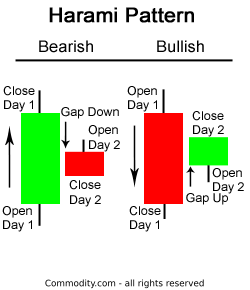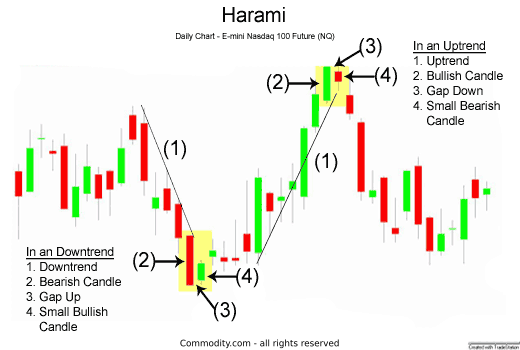The Harami (meaning “pregnant” in Japanese) Candlestick Pattern is considered a reversal pattern. The pattern consists of two Candlesticks:

- Larger Bullish or Bearish Candle (Day 1)
- Smaller Bullish or Bearish Candle (Day 2)
The Harami Pattern is considered either bullish or bearish based on the criteria below:
Bearish Harami: A bearish Harami occurs when there is a large bullish green candle on Day 1 followed by a smaller bearish or bullish candle on Day 2. The most important aspect of the bearish Harami is that prices gapped down on Day 2 and were unable to move higher back to the close of Day 1. This is a sign that uncertainty could be entering the market.
Bullish Harami: A bullish Harami occurs when there is a large bearish red candle on Day 1 followed by a smaller bearish or bullish candle on Day 2. Again, the most important aspect of the bullish Harami is that prices gapped up on Day 2 and price was held up and unable to move lower back to the bearish close of Day 1.
Harami Candlestick Chart Example
The chart below of the Nasdaq 100 E-mini Futures contract shows an example of both a bullish and bearish Harami candlestick pattern:

The first Harami pattern shown above on the chart of the E-mini Nasdaq 100 Future is a bullish reversal Harami. First there was a long bearish red candle. Second, the market gapped up at the open. In the case above, Day 2 was a bullish candlestick, which made the bullish Harami look even more bullish.
Harami Candlestick Potential Buy Signal
A buy signal could be triggered when the day after the bullish Harami occured, price rose higher, closing above the downward resistance trendline. A bullish Harami pattern and a trendline break is a combination that potentially could resulst in a buy signal.
The second Harami pattern shown above on the chart of the E-mini Nasdaq 100 Future is a bearish reversal Harami. The first candle was a long bullish green candle. On the second candle, the market gapped down at the open. The chart above of the e-mini shows that Day 2 was a bearish candlestick; this made the bearish Harami look even more bearish.
Harami Candlestick Potential Sell Signal
A sell signal could be triggered when the day after the bearish Harami occured, price fell even further down, closing below the upward support trendline. When combined, a bearish Harami pattern and a trendline break might be interpreted as a potential sell signal.
A somewhat opposite two candlestick reversal pattern is the Bearish Engulfing Pattern (see: Bearish Engulfing Pattern) and the Bullish Engulfing Pattern (see: Bullish Engulfing Pattern).
Read more at: https://commodity.com/technical-analysis/harami/
Hi everyone ,I could not understand english very well, but it was good.grazie